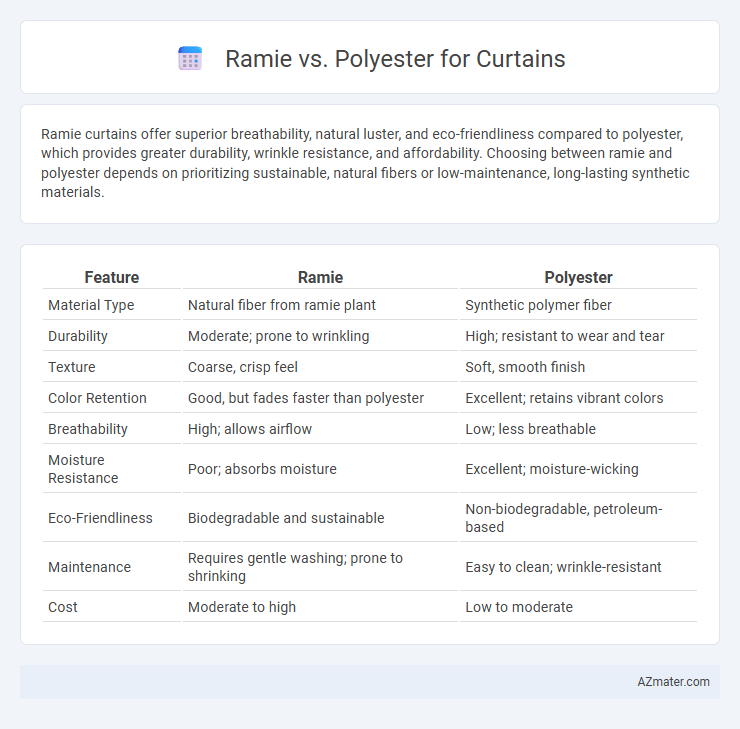Ramie curtains offer superior breathability, natural luster, and eco-friendliness compared to polyester, which provides greater durability, wrinkle resistance, and affordability. Choosing between ramie and polyester depends on prioritizing sustainable, natural fibers or low-maintenance, long-lasting synthetic materials.
Table of Comparison
| Feature | Ramie | Polyester |
|---|---|---|
| Material Type | Natural fiber from ramie plant | Synthetic polymer fiber |
| Durability | Moderate; prone to wrinkling | High; resistant to wear and tear |
| Texture | Coarse, crisp feel | Soft, smooth finish |
| Color Retention | Good, but fades faster than polyester | Excellent; retains vibrant colors |
| Breathability | High; allows airflow | Low; less breathable |
| Moisture Resistance | Poor; absorbs moisture | Excellent; moisture-wicking |
| Eco-Friendliness | Biodegradable and sustainable | Non-biodegradable, petroleum-based |
| Maintenance | Requires gentle washing; prone to shrinking | Easy to clean; wrinkle-resistant |
| Cost | Moderate to high | Low to moderate |
Introduction to Ramie and Polyester Curtains
Ramie curtains are crafted from natural plant fibers derived from the stalks of the Ramie plant, offering breathability, durability, and a lustrous texture that enhances the aesthetic of interior spaces. Polyester curtains, made from synthetic polymers, provide excellent resistance to wrinkles, fading, and shrinking, making them a low-maintenance and cost-effective option for window treatments. Both materials deliver unique benefits: Ramie excels in eco-friendliness and texture, while polyester stands out for durability and ease of care.
Material Composition and Source
Ramie curtains are crafted from natural fibers derived from the stalks of the Ramie plant, a member of the nettle family, offering a biodegradable and breathable fabric option. In contrast, polyester curtains are made from synthetic polymers, primarily polyethylene terephthalate (PET), produced through petrochemical processes that ensure durability and resistance to wrinkles and fading. The natural origin of Ramie provides a textured, eco-friendly alternative, whereas polyester's petroleum-based composition delivers consistent performance and easier maintenance.
Durability and Longevity Comparison
Ramie curtains offer superior durability due to their natural fiber strength and resistance to wear, making them less prone to tearing over time compared to polyester. Polyester curtains excel in longevity by maintaining colorfastness and resisting wrinkles, stains, and mildew, ensuring sustained aesthetic appeal. Combining natural resilience with synthetic durability, polyester curtains typically outperform ramie in long-term maintenance and stain resistance.
Texture and Appearance Differences
Ramie curtains offer a natural, slightly coarse texture with a matte finish that enhances rustic and organic interior styles. Polyester curtains provide a smooth, lightweight texture with a subtle sheen, creating a sleek and modern appearance. The natural irregularities in ramie fibers give curtains a unique tactile character, while polyester's uniform surface ensures consistent color and drapability.
Breathability and Airflow
Ramie curtains offer superior breathability and natural airflow due to their loosely woven fibers, making them ideal for maintaining fresh indoor air and reducing humidity. Polyester curtains, while durable and wrinkle-resistant, have a tighter weave that limits air circulation and traps heat, potentially reducing room ventilation. Choosing ramie enhances airflow and promotes a cooler environment, especially beneficial in warm climates or spaces requiring optimal moisture control.
Light Filtration and Opacity
Ramie curtains offer natural light filtration with a soft, semi-sheer texture that diffuses sunlight gently, creating a warm and airy ambiance. Polyester curtains provide higher opacity, blocking more light and enhancing privacy, making them ideal for rooms requiring darkness or insulation. When choosing between ramie and polyester for curtains, consider the desired balance between natural light diffusion and light-blocking capability.
Maintenance and Cleaning Requirements
Ramie curtains require gentle hand washing or dry cleaning to maintain their natural fibers and avoid shrinkage, with frequent vacuuming recommended to remove dust. Polyester curtains are more durable and low-maintenance, supporting machine washing, quick drying, and resistance to wrinkles, mold, and mildew. Choosing polyester reduces cleaning frequency and effort, making it ideal for busy households or humid environments.
Environmental Impact and Sustainability
Ramie curtains offer a more sustainable and eco-friendly alternative to polyester, as ramie is a natural fiber derived from the stalks of the Chinese nettle plant, requiring less water and pesticides during cultivation. Polyester, a synthetic fiber made from petroleum, contributes significantly to environmental pollution through non-biodegradability and microplastic release during washing. Choosing ramie over polyester reduces carbon footprint and supports biodegradable textile options, promoting a more circular economy in curtain manufacturing.
Cost Comparison: Ramie vs Polyester Curtains
Ramie curtains typically cost more than polyester curtains due to the natural fiber's labor-intensive harvesting and production processes. Polyester curtains are more budget-friendly, benefiting from mass production and synthetic material costs, making them an economical choice for large-scale purchases. While ramie offers a luxurious texture and eco-friendly appeal, polyester provides a cost-effective solution with greater durability and stain resistance.
Best Use Cases for Each Fabric
Ramie curtains excel in eco-friendly, breathable, and natural aesthetics, making them ideal for living rooms or bedrooms seeking a rustic, organic vibe with excellent light filtration. Polyester curtains offer superior durability, wrinkle resistance, and color retention, perfect for high-traffic areas like kitchens or offices that require long-lasting, easy-care window treatments. Choosing between ramie and polyester depends on the desired balance between sustainability and performance in specific interior settings.

Infographic: Ramie vs Polyester for Curtain
 azmater.com
azmater.com